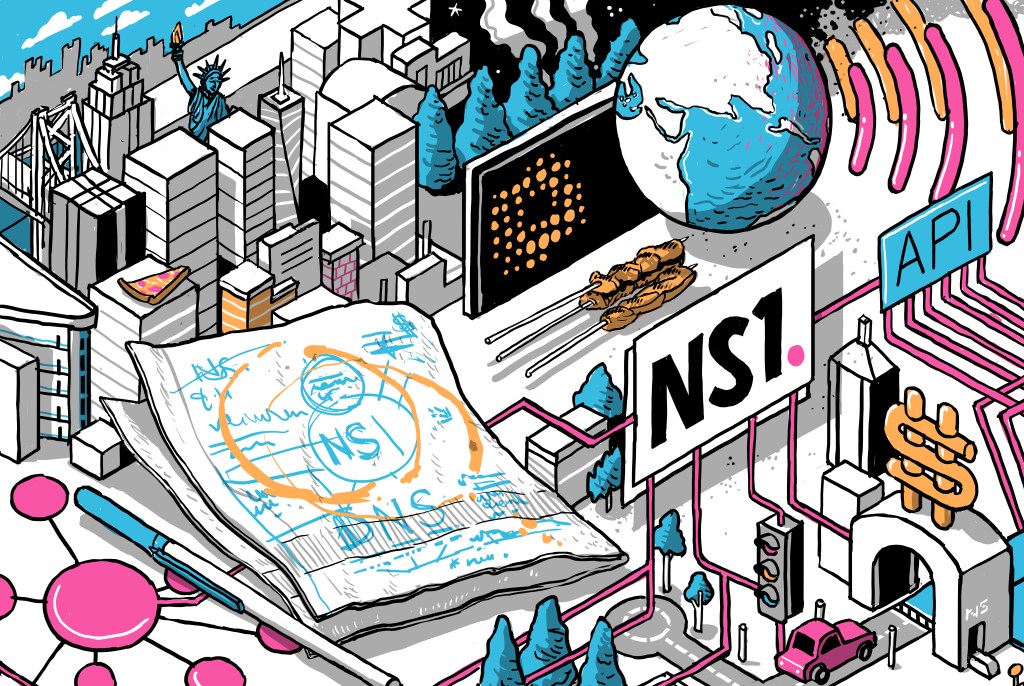It’s the most important primary layer in the modern tech stack for internet software, and its most intriguing evolution was written on a napkin in a New York City bar and translated to just shy of two dozen lines of Python code.
Such is the nature of tech innovation today, and such was the birth of NS1. Kris Beevers, along with Jonathan Sullivan and Alex Vayl, wanted to rebuild the core addressing system of the internet — the Domain Name System, or DNS — and transform it from a cost center into a critical tool for software reliability and cost savings. It was a smart idea back in 2012 and gained much steam a few years later when a fortuitous outage at a competitor left hundreds of websites stranded.
NS1 may make the networks of the internet more reliable. But the story of the company is also built on the back of a durable social network of engineers who met at a little-known NYC startup named Voxel. That startup would go on to become, unintentionally, an incubator for several massive enterprise companies and exits.
Chance encounters, bold engineering and lucky breaks: It’s the quintessential startup tale, and it’s changing the face of software delivery.
“You learn a lot because you’re doing way more than you rightfully should.”
NS1’s story begins back at the turn of the millennium, when Beevers was an undergrad at Rensselaer Polytechnic Institute (RPI) in upstate New York and found himself employed at a small file-sharing startup called Aimster with some friends from RPI. Aimster was his first taste of life at an internet startup in the heady days of the dot-com boom and bust, and also where he met an enterprising young engineer by the name of Raj Dutt, who would become a key relationship over the next two decades.
By 2007, Beevers had completed his Ph.D. in robotic mapping at RPI and tried his hand at co-founding and running an engineered-wood-product company named SolidJoint Research, Inc. for 10 months. But he soon boomeranged back to the internet world, joining some of his former co-workers from Aimster at a company called Voxel that had been founded by Dutt.
The startup provided a cornucopia of services including basic web hosting, server co-location, content delivery and DNS services. “Voxel was one of those companies where you learn a lot because you’re doing way more than you rightfully should,” Beevers said. “It was a business sort of built out of love for the tech, and love for solving problems.”
The New York City-based company peaked at some 60 employees before it was acquired in December 2011 by Internap Network Services for $35 million.
Internap Buys Hosting, Cloud Services Company Voxel For Up To $35 Million
“Voxel was a really formative experience not just for me, but I think for almost everybody that was there,” Beevers said. Indeed, the company’s tech-centric culture and penchant for entrepreneurship would prove a wellspring of future NYC-based startups.
Dutt would leave Internap to start Grafana, an open-source data visualization vendor that has raised over $75 million to date. Voxel COO Zachary Smith went on to found bare metal cloud provider, Packet, in 2013, which he ran as CEO until the company was acquired by Equinix in March 2020 for $335 million. Meanwhile, Justin Biegel, who spent time at Voxel in operations, has raised nearly $62 million for his startup Kentik. And of course, NS1 was birthed from the same alumni network.
“It turned out to be a tremendous incubator for a bunch of people to go on and start new companies based on their experience at Voxel,” Dutt said. “In retrospect, that was one of the best possible educations in internet infrastructure and scaling distributed systems.”
The experience of growing Voxel taught critical lessons. One of those lessons, according to Dutt, was that you can have a really cool product that’s technically compelling, but unless you have a really solid go-to-market engine around it, no one will care.
“We were a bunch of engineers and we had the typical technical founder mindset of, like, “Hey, if we build a better mousetrap, the world will beat a path to our door,” he said. “Nope, that’s not the way the world works, right? So that was definitely a big lesson.”
Another big lesson was the importance of having capital to meet windows of opportunity. “We were constantly struggling to meet payroll and to buy new servers, and we could only grow as fast as our organic cash flow allowed,” Dutt said. “In retrospect, if we had been better capitalized, we could have taken that company a lot further.”
Those key lessons were not lost on Beevers when it was time for him to build NS1.
Singaporean satay, and cat pics for everyone at the speed of light
Beevers’ big idea behind NS1 emerged from a content delivery network (CDN) that he helped build at Voxel.
As the name implies, a CDN is a network service that helps distribute and deliver content, say, pictures of cats. Users want to see a cat picture as soon as possible, and the host delivering that cat pic also wants to deliver it just as quickly, with the best experience while minimizing costs. That was an optimization puzzle and infrastructure challenge that Voxel figured out with its own CDN offering.
His stint as the principal software architect at Voxel saw Beevers living in Singapore from 2008-12. He was out one evening with CEO Dutt, eating satay on a street and talking about the challenge of how Voxel was steering traffic across its own CDN infrastructure to accelerate traffic. That meant optimizing DNS.
DNS is a service that connects IP addresses for a single server, like 212.82.100.163, to a domain name like techcrunch.com. When the world wide web was just getting underway, most websites were hosted on a single server since there just wasn’t enough scale that required anything more advanced.
Over time, however, websites had to manage millions of connections with users, far outside the capabilities of even the highest-performance server. Top websites needed dozens, then hundreds, and today millions of servers to operate, and DNS therefore needed to evolve as well. Today, DNS directs traffic at sub-microsecond response times to specific servers based on who is connecting and what the user wants to access.
A decade ago, Voxel needed to define a complex set of traffic steering rules that would optimize the best route to serve a request from one of their users. What Beevers and Dutt realized was that Voxel’s customers had the same kind of traffic steering challenges with their own infrastructures.
Beevers really liked the idea of having some form of service that could help organizations optimize traffic and DNS. He recounts that there were only a few internet properties at the time that performed well across the world. Google was one of the few, and it achieved it with a massive investment in moving code and data centers closer to major population centers around the world.
“By the time I left Singapore in 2012, everybody recognized that users in Singapore matter just as much as the users in Ashburn, Virginia, just as much as the users in Amsterdam and Europe and South America and Africa and so on,” Beevers said. “You can’t beat the speed of light, so you’ve got to put the code and the data closer to those audiences.”
Beevers would soon recognize that the very problems he had solved within Voxel were problems others had as well, and that realization would become the spark for NS1.
Name Server 1
After years in Singapore, Beevers returned to New York City in 2012. On a crisp day in early 2013, Beevers and Jonathan Sullivan, a co-worker from Voxel, went out after work to Fraunces Tavern, which was located just around the corner from Voxel’s headquarters in lower Manhattan.
It was at that tavern over a frothy stout that the initial sketch for what would become NS1 was drawn on a napkin that Beevers says he still has … somewhere. The idea built on the conversation that Beevers had in Singapore a year earlier with Dutt, except this time, it wasn’t just idle conversation — it was the beginning of a new enterprise.
In the days that followed, fellow Voxel co-worker Alex Vayl joined Sullivan and Beevers to start NS1. Beevers says each of the co-founders had a particular strength: his strength was software development, while Vayl brought marketing expertise and Sullivan delivered operations know-how.
The three didn’t have to go far to christen the newly founded company.

At the core of DNS are name servers, which act as directories connecting human-readable domain names to numeric IP addresses of servers. Commonly and historically, sites and internet service providers (ISPs) have listed the first name server in a domain record as “ns1,” for Name Server 1. For instance, TechCrunch’s first name server is ns1.techcrunch.com and connects users from “techcrunch.com” to the IP address of one of our servers.
It made for an obvious name for the new startup, and as it turns out, Beevers already owned the domain name NS1.com. It wasn’t something he came up with and bought in 2013 either — he’d actually bought the name way back in 1996.
“I’m like most other technologists, when I have free time, sometimes I’m like, ‘What cool domains can I think of?’ and so I bought the domain,” Beevers said. “It was as simple as that.”
Call it prophetic or happenstance, NS1 was underway.
From Python on the couch to raising venture dollars
From a technical perspective, the genesis of NS1 was 22 lines of Python code that Beevers wrote while sitting on his couch in his NYC apartment to sketch out what would become NS1’s filter chain technology. That’s the company’s main engine for steering DNS traffic based on a set of rules and policies — the idea inspired by working on the same challenge at Voxel.
Those 22 lines have obviously ballooned into many more lines of code over the years, but for Beevers, they are emblematic of the company he created: NS1 is all about trying new things and experimenting. The first 22 lines of code were good enough that Beever could host his own and friends’ personal domains, and it kept improving and growing.
“That iterative approach really helped us get going,” Beevers said.
The co-founders put together an initial seed round for NS1, which saw participation from Dutt, formerly Voxel’s CEO. Dutt says he didn’t invest in NS1 as a charity or out of a sense of altruism to help out Beevers. He instead emphasized that it was a very capitalistic move and he was confident Beevers’ experience and talent would lead to a profitable outcome.
It was really only after NS1 began making money that Beevers went out looking for venture capital to scale the business. He built the company’s first official pitch deck with Dutt, hoping that a well-tuned pitch and the team’s ample technical acumen would let the company lock in a round of financing quickly.
It didn’t work out that way, however: The journey to the first venture round was a tedious endeavor and involved over 70 pitches.
Beevers says he approached the process with iteration in mind, much like he had with expanding the initial 22 lines of code. “We’re experimentalists and iterative as a company,” he said. So, he and his co-founders took home lessons on what they needed to do better after each pitch.

What they learned from feedback was that it was critical to have a stronger education piece. DNS may be an acronym widely known in tech circles, but it’s one of those technologies that very few engineers — let alone VCs — had ever thought deeply about. Investors needed to understand what had changed in the world that made NS1’s technology stand out, and why DNS was an interesting part of the tech stack ripe for innovation.
But even with those questions satisfied, Beevers still had to answer why NS1 was positioned to execute on his vision, and why incumbents like DynDNS, which were already providing DNS services, were unable to do it.
“Eventually we found, of course, investors who were receptive to that idea, technical enough to get it right and willing to engage with our team enough to believe that we could address this challenge,” Beevers said. Ultimately, NS1 closed a $5.4 million Series A round led by Flybridge and Sigma Prime on April 7, 2015.
A year later, in September 2016, the company raised a $23 million Series B from Deutsche Telekom Capital Partners, Telstra and Two Sigma. Beevers explained that he was purposeful about partnering with big players in the telecommunication ecosystem like Deutsche and Telstra.
The logic was simple: The two telcos have large footprints and great connectivity, particularly in EMEA and Asia, and NS1 wanted to improve its capacity and performance in those markets at the time. Both telcos also had some experience with security, which was becoming increasingly important at that time, and was a factor that would become absolutely critical a few weeks after the Series B closed.
Into the fires of the DDoS armageddon with DynDNS
“What happened between the B and B1 funding round was the DynDNS attack — which was an infamous internet event,” Beevers said. “It was on October 21, 2016, I remember the day, because it was sort of an inflection in our business. Dyn was a tooth-and-nail competitor at the time, you know; obviously not so anymore.”
DynDNS back in 2016 was a major managed DNS service provider. On that linchpin date, it was the victim of a volumetric distributed denial of service (DDoS) attack, which involves attackers seeking to overwhelm a service by flooding it with a massive surge of sustained traffic. TechCrunch and other media outlets reported on the DynDNS attack at the time, which crippled large swaths of the internet, including Twitter, Reddit, Spotify, GitHub and SoundCloud, among others, and made the websites inaccessible.
“Almost immediately after that event, our business changed quite a bit,” Beevers said.
Engineers recognized after the 2016 DynDNS attack that they had to have more redundancy in their DNS infrastructure. Beevers recalled that there was a large groundswell in demand for NS1 services as organizations realized they needed another managed DNS option. That impact extended into 2017, when NS1 raised its $20 million Series B1 in September from GGV and Salesforce Ventures.
Over the next two years, NS1 grew its product and services lineup, pushing beyond its core managed DNS roots into adjacent areas of enterprise networking. It also raised more capital to back its forays. It raised its $33 million Series C backed by Dell and Cisco Investments in October 2019, and a $40 million Series D led by Energy Impact Partners in July last year.
Beevers said that the 2020 fundraise was part of the continued realization at internet companies that the world is changing really quickly and the network is at the core of everything. It’s a realization that he’s known for years — all the way back when he bought the NS1.com domain name in 1996 and when he scribbled on the napkin at Fraunces Tavern in 2013.
“What makes DNS such an interesting opportunity is that it is totally pervasive. Every application on the network speaks DNS; everything on the internet starts with typing something [dot] com in your browser and pressing enter, or in your app, it’s connecting to app.whatever.com,” Beevers said.
DNS alone isn’t what makes NS1 a successful enterprise vendor — it’s just a conduit for the company’s true value and promise of making applications and services run better. In the second part of this EC-1, we take a deep dive into the technology and services that NS1 provides.
NS1 EC-1 Table of Contents
- Introduction
- Part 1: Origin story
- Part 2: Product development and roadmap
- Part 3: Competitive landscape
- Part 4: Customer development
Also check out other EC-1s on Extra Crunch.































Comment